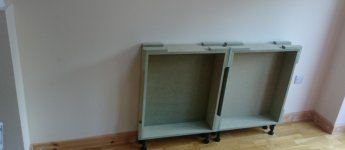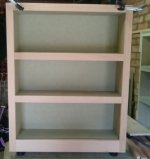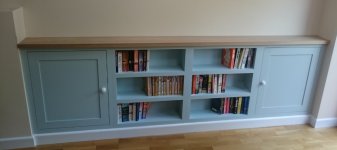Hi All
I've lurked here for ages so thought I'd post a recent project of mine.
Firstly a bit of context. I’m a hobbyist woodworker with big ambitions…to eventually build my own kitchen I drool over the professional kitchens posted on woodwork forums and would love to try to create something as special one day.
I drool over the professional kitchens posted on woodwork forums and would love to try to create something as special one day.
So when my wife asked if I could create a “feature” built-in unit to fill some dead space in our new dining room extension I decided to use it as a mini dry run of building and installing kitchen cabinets…of a sort. I have zero experience of building kitchen cabinets so basically used guesswork gleaned from all the WIPs I’ve seen.
I’d love to hear any feedback from you guys on where I went wrong or how the pro’s would do something differently.
The space, as you will see, is long but not very deep so to create practical storage we decided to go for 2 bookshelves and two cupboards.
The first step was to build the boxes. As everything would be painted I used standard 18mm MRMDF (as opposed to veneered) with beech face frames. All 4 were built to the same size with the exception of the 2 outside face frame stiles which were made wider to allow for scribing. The face frames were the first question mark. Having looked at the WIPs and asking a few questions on the forums I knew most face frames are around 36mm wide so guessed an 18mm filler piece would be needed as a backer to the face frame and also to create a secure fixing to the nextdoor cabinet box. Is that what’s normally done?
[attachimg=2]
[attachimg=3]
I then installed them which was a pretty simple process using a combination of adjustable feet for the floor and shims for the wall.
[attachimg=4]
[attachimg=1]
I then fitted the skirting and the doors using euro hinges to set the door inside the frame. This is a second quesiton mark. The doors are nearly 800mm wide and suffer from slight sagging issues. It could be down to the quality of the hinges or it could be because such wide doors are a no-no. Any opinions on this?
I then painted the cabinets to the wifes spec using a watered down eggshell paint and foam brush.
Finally I scribbed and fitted a 30mm thick oak top finished in danish oil to match the colour of the kitchen tops. Squeezing it in the space created a few marks and dents that need repairing but overall not too painful.
[attachimg=5]
All we need now are some decent looking books for the bookshelves
Cheers
Ed
I've lurked here for ages so thought I'd post a recent project of mine.
Firstly a bit of context. I’m a hobbyist woodworker with big ambitions…to eventually build my own kitchen
So when my wife asked if I could create a “feature” built-in unit to fill some dead space in our new dining room extension I decided to use it as a mini dry run of building and installing kitchen cabinets…of a sort. I have zero experience of building kitchen cabinets so basically used guesswork gleaned from all the WIPs I’ve seen.
I’d love to hear any feedback from you guys on where I went wrong or how the pro’s would do something differently.
The space, as you will see, is long but not very deep so to create practical storage we decided to go for 2 bookshelves and two cupboards.
The first step was to build the boxes. As everything would be painted I used standard 18mm MRMDF (as opposed to veneered) with beech face frames. All 4 were built to the same size with the exception of the 2 outside face frame stiles which were made wider to allow for scribing. The face frames were the first question mark. Having looked at the WIPs and asking a few questions on the forums I knew most face frames are around 36mm wide so guessed an 18mm filler piece would be needed as a backer to the face frame and also to create a secure fixing to the nextdoor cabinet box. Is that what’s normally done?
[attachimg=2]
[attachimg=3]
I then installed them which was a pretty simple process using a combination of adjustable feet for the floor and shims for the wall.
[attachimg=4]
[attachimg=1]
I then fitted the skirting and the doors using euro hinges to set the door inside the frame. This is a second quesiton mark. The doors are nearly 800mm wide and suffer from slight sagging issues. It could be down to the quality of the hinges or it could be because such wide doors are a no-no. Any opinions on this?
I then painted the cabinets to the wifes spec using a watered down eggshell paint and foam brush.
Finally I scribbed and fitted a 30mm thick oak top finished in danish oil to match the colour of the kitchen tops. Squeezing it in the space created a few marks and dents that need repairing but overall not too painful.
[attachimg=5]
All we need now are some decent looking books for the bookshelves
Cheers
Ed





